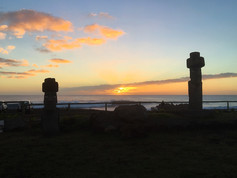Visit the Famous Moai on Easter Island
- thebrieadventure

- Jan 7, 2018
- 5 min read
Practically everyone has seen images of the massive Moai statues from Easter Island, but much of their origins and history remains a mystery. One of the major deterrents to visiting Easter Island is how remote this small island is located nearly 2,200 miles off the coast of Chile. However, if booked far in advance round trip tickets from Santiago are extremely reasonable and it is easy to make this unique island an affordable destination!
Easter Island is most famous for its Moai statues which were carved from stone found on the island by the Rapa Nui people between 1,100 and 1,500 CE according to experts. Although there are 887 statues scattered all around, a few spots still have large ceremonial platforms (ahus) with several Moai on top. Ahu Tongariki, Ahu Tahai, Anakena Beach, Ahu Akivi, and the Rano Raraku quarry offer several of the most well-preserved Moai to visit when exploring island. Yet there are numerous other statues and historical ruins dispersed around Easter Island that are well worth visiting. Here are a few of the highlights that I would definitely recommend to anyone interested in exploring this fascinating tropical gem:
Bike the island- Although there are a litany of tours and rental cars available, due to the small size of the island (and wanting to stay active on my extended travels) I opted to rent a bicycle. Immediately upon arrival, I picked up the bike, found a map, and was off peddling. One of the upsides to the island being only 63 square-mile is that there are limited roads, making it easy to navigate. Even Anakena Beach which is one of the further points on the island from the main town of Hanga Roa, was only a 9 mile ride. Starting out, I thoroughly enjoyed biking the hilly green landscape while soaking up the surrounding scenery... that is until my front tire went flat. In the middle of nowhere and miles away from the shop, I noticed it was extremely difficult to peddle and looked down to see that the tire was completely flat. Reluctantly I got off it and began pushing the bike back up the hill towards town. Thankfully only a few minutes later someone passed in a truck and offered me a ride which was only the first of many gestures of hospitality from the locals who kindly welcomed visitors. After swapping the bike out I took off again, this time in the opposite direction up the west coast to visit several of the Moai on that side of the island. It is definitely possible to do a full circuit around the island in a day, but almost any route will include significant portions that are uphill. Over-all it was a great work-out and an easy way to see a significant amount of island.
Hike a Volcano- Rano Kau is an extinct volcano just over a thousand feet tall that forms the southwestern headland of Easter Island. The center of this former volcano has a crater lake deep in the center of the high ridges, which is one of the island's only three natural bodies of fresh water. The center crater is almost a mile across and has its own micro climate because it is sheltered from the strong winds that sweep the rest of the island. At the far side of Rano Kao on the ledge that divides the crater from the ocean far below, lies the ruins of the ceremonial village of Orongo which is perched on a cliff face that drops sharply down to the sea shore some 980 ft below. The ruins in this historic village consists of approximately 53 elliptically shaped houses overlooking the ocean and it was used between 1600 and 1866 AD as the center of the birdman cult. It is an easy hike from downtown Hanga Roa to the top of the volcano, but there is also a parking lot at the top of the crater near the entrance to Orongo if you choose to visit by car.

Scuba Dive- The clear visibility, abundance of sea life, and famous sunken Moai statue made the dive at Easter Island one of my absolute favorite dives. There is one Moai statue that was placed out in the ocean close to the bay by the local inhabitants as a token of gratitude to the older generations for passing down the skills necessary to live off the sea as well as a sign of respect for everything that the water provides the island. The dive is an extremely simple one, only about 40 meters’ depth and an easy 10-minute boat ride from the coast, but there are plenty of turtles and variety of fish to keep the dive interesting not to mention the main attraction- the massive Moai statue.
Camp with a view- Although there are numerous eco-lodges and hotel accommodations that make it possible to do this trip comfortably, it is a perfect place to stay simply and explore the outdoors! I was very satisfied with my stay in a tent next to the water in the Hanga Piko Bay mostly because every night I got to fall asleep to the sound of waves crashing against the cliffs just a few meters away. Since I was backpacking for several months, I had limited gear with me so I was thankful that the rental included a tent, sleeping mat, and sleeping bag which were all in fairly good condition especially since it only cost $15 a night. The camping grounds also offered bathrooms with showers (with limited hot water though which is common across island), a huge kitchen/dining room, and surprisingly good wifi. They also arranged pick-up at the airport and had a flower lei waiting to welcome me when I stepped off the plane!
Catch sunset at Ahu Tahai- Tahai is one of the larger series of Moai and is located in one of the best places on island to enjoy sunset. There are technically three different ahu found at the site, from left to right- Ahu Vai Uri- includes the five Moais in the picture, Ahu Tahai- the single and quite eroded Moai that is also in the picture, and finally, Ahu Ko Te Riku, which is a single Moai further to the right with eyes and a pukao headdress. This is an idyllic spot in the evening because the sun sets right behind the large statue silhouettes. Although I did not catch any spectacular sunsets there, even with just mediocre lighting it was still quite the experience.
Pro tip: Plan to visit during the Tapati Rapa Nui festival. Each year the locals compete in an island-wide contest for the title of “Queen of the Island.” During the celebration, the island is divided in two parts which constitute alliances or clans which each choose a queen to represent them during the competitions. The rigorous competition between the two clans lasts for several days and nights throughout the festival where various participants use their physical and artistic skills to earn points for their respective candidate. At the end of the festival, the queen of the clan with the most points wins the crown and title. The culminating event is the Rapa Nui triathlon which is held in Rano Raraku and consists of three traditional races: the Vaka Ama- canoeing in small reed boats across the lake, swimming with a Pora or a reed float, and the Aka Venga where contestants sprint while carrying two bananas clusters on their shoulders. The festival is held during the first two weeks of February and all of the locals that I talked to highly recommended returning to watch the events!
































Comments